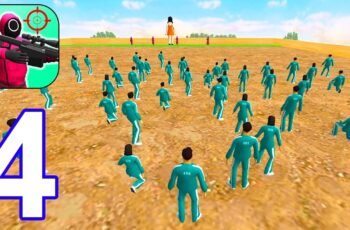Calling all thrill seekers! The world of hunting sniper game is like stepping into a high-stakes wildlife drama—cool, suspenseful, and rewarding. From the first aim to the final shot, every moment crackles with excitement. Think of yourself as an artist; your rifle is the brush, and the wild is your canvas. In this guide, you’ll get clarity on gear, techniques, and pro tips all in a friendly, chatty tone that feels like a buddy’s advice. By the end, you’ll feel prepared and pumped to dive into your next adventure. Ready to unlock your inner sniper and become a hunting legend?
What Makes a Great Hunting Sniper Game?
A standout hunting sniper game grabs your attention from the start. It’s about realistic environments rugged forests, frozen mountains, golden savannas. You should feel the wind, sense the rustle of leaves, and even hear distant bird calls. But it’s not just about pretty graphics; a great game delivers immersive ballistics, sharp wind effects, and realistic bullet drop. Here’s a metaphor: if archery games give you the calm of painting, a sniper game drops you in the middle of an action thriller. You’re not just playing; you’re living it. It’s personal and intense. Storylines involve tracking elusive game, mastering gear, and facing challenges that push your strategy skills. Add regular updates, new maps, and dynamic weather and you have a game that pulls you back in time after time.
Getting the Right Gear: Rifles, Scopes, and More
In a hunting sniper game, choosing your gear is like picking a recipe you have to balance flavors. Rifles range from bolt-action classics to futuristic designs. Scopes magnify your world, turning tiny blips into clear targets. Then there are attachments bi-pods for stability, silencers for stealth, and advanced ammo for precision. Think of it like assembling a Swiss Army knife. Every piece adds a new function. To really nail that shot, customize your gear to your playstyle. Prefer long-distance precision? Opt for a high-powered scope and heavier rounds. Like quick reactions? Choose mobility gear and lighter ammo. The game’s economy might even let you swap parts as you earn rewards. And don’t forget practicality—lighter gear means faster movement. Practice frequently to learn your setup’s quirks, like wind sway and recoil. The more you experiment, the more it feels like tailoring a suit it fits perfectly to you.
Mastering Ballistics and Bullet Drop
Picture the hunting sniper game bullet as a waterfall it doesn’t shoot straight like a laser; it arcs. That arc? It’s called bullet drop. Then add wind, gravity, and distance. Ballistics is the math behind it all. Beginners often miss the mark because they forget to account for these variables. But once you understand, it’s like unlocking a secret code. A quick tip: observe the reticle marks inside your scope. They’re your best friends. When you line up a shot, imagine the bullet’s flight path like a gentle curve aim a bit above your target if it’s far away. Wind is like a playful pup nudging your bullet left or right. Adjust accordingly. Practice in-game ranges, spot fictional targets at different distances, and experiment. As you play more, these corrections become second nature, almost like humming your favorite tune. It’s not just a game; it’s a brain-tease that sharpens your spatial awareness and timing.
Tracking, Patience, and Spotting Vitals
Ever watched a lion stalk its prey? That’s the vibe you aim for in a hunting sniper game. It’s quiet. It’s still. Your eyes are scanning every brush, every shadow. Tracking is about understanding movement: broken twigs, shifting grass, or hoofprints tell stories about where animals moved. Patience is your secret weapon hold your breath, steady the scope, and wait. It’s a chess match in real time. Spotting vitals neck, heart, lungs is like hitting the bullseye on a dartboard. It’s not about hitting the largest area; it’s about precision. A headshot may be flashy, but a clean chest or neck shot is what brings game down ethically and quickly. Practice your spotting skills by pausing the action and scanning each animated animal slowly. Most games offer a mode to freeze-frame, letting you study vital points before trying live shots. Soon, spotting becomes instinctual a skill as natural as catching your phone when it slips.
Navigating Maps, Weather, and Time of Day
In a hunting sniper game, maps are more than backdrops they’re puzzles. Mountain ridges offer elevation advantage; rivers block travel, and thick forests hide both predator and prey. Learn each map’s layout like you would the streets of your hometown. Then comes weather: fog is your cloak; rain muddies tracks; wind directions shift ballistics. At dawn or dusk, animals roam more, but visibility dips. These elements weave together to challenge you in unpredictable ways like cooking a tricky recipe with surprise ingredients. A pro player reads conditions and adapts. If it’s foggy, slow down and listen. On a windy map, choose your shots carefully or find shelter. Daytime hunts are clean and clear; night hunts feel mysterious and intense. Mastering these environmental shifts makes your gameplay richer, smarter and a lot more satisfying.
Strategies for Multiplayer and Competitive Modes
Switch gears now you’re in a hunting sniper game, but against other players. Think of it like a tactical paintball match, where every move is strategic. Multiplayer modes often introduce objectives: secure zones, eliminate rivals, or survive timed rounds. Communication is gold. Use voice or ping systems to coordinate “target at 300m, southeast.” Covering teammates, alternating positions, and sharing intel about enemy movement can swing the match. And mind games are key: fake shots, repositioning, decoys. Studying your opponents’ habits like they always peek at a certain rock lets you set traps. Check their gear, know their favorite maps. Every match becomes a mini thriller. Win or lose, analyze your play afterward. Did you hold too long in one spot? Could you have predicted an ambush? This post-game review turns losses into lessons and victories into repeatable triumphs.
Tips to Improve: Practice Modes and Self-Review
Want faster progress in the hunting sniper game? Treat it like learning an instrument: daily practice and self-review. Start with practice ranges: shoot static targets, adjust for wind, track bullet flight. Then switch to moving targets to work on timing and reaction. Record your gameplay if possible. Watch replays to catch mistakes did you rush the shot? Miss wind calls? Overlook stealth? The best players are their own coaches. Join communities or forums and watch top-tier gameplay. Seeing how others approach scenarios will open your mind to new tactics like learning new recipes by watching a master chef. Stay curious. Play different maps, refresh your setup, tweak gear. Train patience and precision. And don’t forget: celebrate every milestone. First long-range kill? That perfect headshot in multiplayer? Give yourself a pat on the back. These small wins build confidence, making you not just a better player, but a more fulfilled one.
Conclusion: Embrace the Hunt and Grow
Diving into the world of hunting sniper game is about more than shooting it’s about awareness, strategy, patience, and growth. You start with gear, learn ballistics, map dynamics, adapt to weather, and sharpen your skills in solo and multiplayer modes. Every session becomes a lesson, and every miss brings insight. Keep practicing, stay observant, and lean on the community. Before you know it, you’ll be the player everyone tunes in to watch or fears sneaking up from a distance! Now grab that scope, breathe steady, and take your shot. Welcome to the hunter’s brotherhood.

